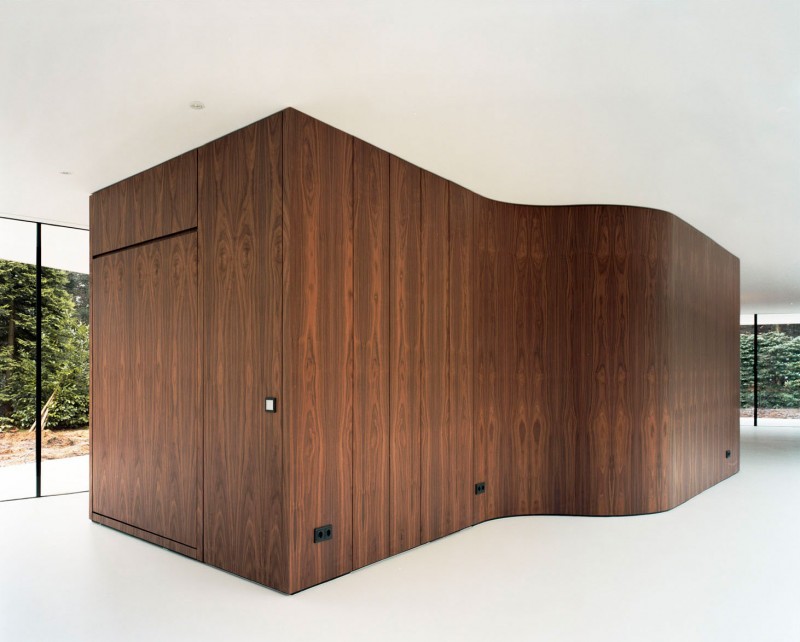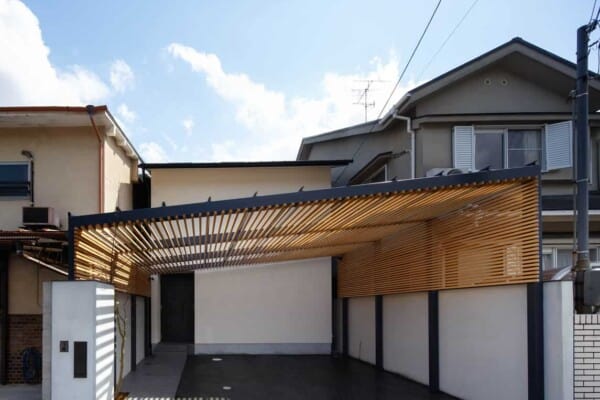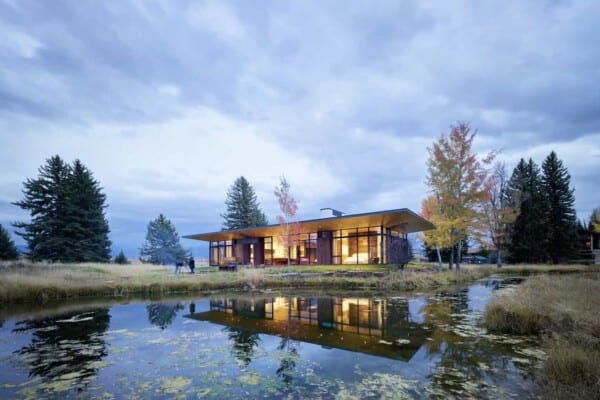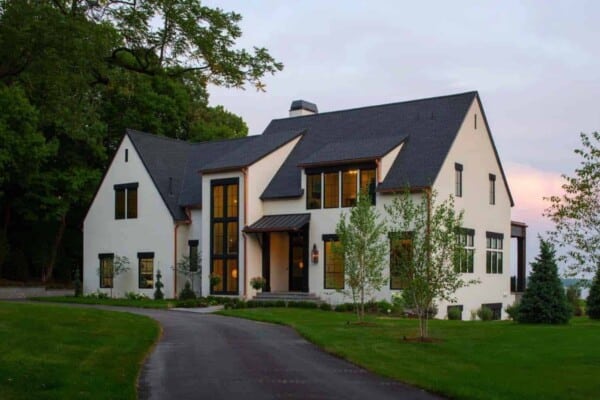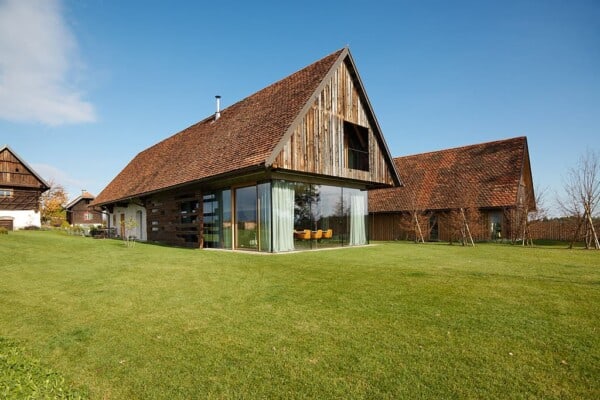Rotterdam-based studio Powerhouse Company has designed the Villa 1.
Completed in 2008, this single story contemporary home is located in Ede, a town in the province of Gelderland, the Netherlands.
Villa 1 by Powerhouse Company:
“Villa 1 was the first commission for Powerhouse Company, two months after its founding in May 2005. Set in a clearing in a large pine forest, the program of Villa 1 is oriented optimal towards the views on the terrain and the sun. Half of the program is pushed below ground to meet local zoning regulations. This creates a clear dichotomy in the spatial experience of the house – above ground a ‘glass box’ ground floor where all mass is concentrated in furniture elements and below ground a ‘medieval’ basement, where the spaces are carved out of the mass.
The site offers beautiful views on the forest and has a great sun exposure that we wanted to fully take advantage of. The typical Y shape of the plan is the result of the optimal configuration of the program on the ground floor towards sun and view. There are three wings: one wing for work, studying and music making (North exposure); one for cooking and eating (East-South-West exposure); and one for living and painting (South and North exposure). The central area where all wings meet is the heart of the house. It is a large space that serves as entrance hall, dining room, bar and music-room.
In the basement, the Y-shape creates a similar functional clarity: one wing is for the master bedroom, one for cars and one for storage and guest rooms. A patio provides light for the guest rooms.
A singular frame envelopes the house. The Y plan stretches the house into the site and provides large panoramic views on the surrounding scenery. On the South and East sides, two large covered decks create passive sun shading for the interior, while leaving the terrace in the sun.
Each wing is spatially organized in a centrifugal manner. All mass is concentrated in a central core: a piece of furniture that contains all services and structural elements and that simultaneously creates different rooms within the entirely glazed space. These large pieces of furniture create a free flowing distribution of functions without closing off rooms. It is thus possible to enjoy a pleasant stroll longer than 150 m through a variety of rooms immersed in the landscape.
The three furniture pieces on the ground floor are distinctively different in their design, materials, feel and smell. We used wood to the North, slate to the East and concrete to the South. In the North wing an American nut-wood furniture piece ‘swallows’ a staircase, cupboards, guest bed and a small bathroom. The curves of its outer shape create the entrance, a small and a large study and an acoustically sound piano-room. The kitchen is the second piece of furniture. It is entirely made of Norwegian slate and incorporates all kitchen appliances and storage, a toilet and a bar. It is as solid as a rock, yet gentle in its use – a sort of primordial sophistication. The third furniture piece consists of two concrete walls that incorporate a fire place, storage and video projector. This element opens up to create a patio bordered by a living room, garden room and atelier.
Counteracting the extreme openness of the ground floor, the basement level shelters the most intimate rooms of the house and takes on opposite spatial qualities, emphasized by the brutal and protective feeling of mass. Here, the scarcity of daylight is complemented by a richness in spatial effects. The rooms are carved out in the mass, creating vaulted ceilings and thick walls as a paradoxical result of the lightness of the vertical structure above ground. In the basement the heavy architecture retrieves the primordial qualities of Roman architecture.
The glass facade is suspended between window frames hidden in the ceiling and floor. There is no vertical structure, only silicone joints to hold the glass. There is one large in the glass facade: a huge green marble sliding wall (a sort of mobilized Mies wall) which opens the intimacy of the living room onto the terrace. Although made of marble, the sliding wall is very light as it is mounted on honeycomb aluminum plates (a Chinese invention called stone-veneer now produced in Texas, USA, with predominantly Middle East stones). The marble sliding wall wraps around a cross-shaped column clad with a black rubber skin: this is what we called the “Miessian Gimp” (a reference to the Gimp character from Pulp Fiction).
Structurally the house is a stack of different industrial building techniques. The basement is cast in concrete. The roof, with extreme cantilevers, is a complex steel structure designed by the audacious structural engineer Gilbert van der Lee. The bookshelf in the North wing is made entirely of solid steel plates and functions as a structural ‘Vierendeel’ frame stabilizing the structure of the roof.
As a result of its Y shape and architectural dichotomy, the villa provides a wide array of extreme spatial qualities, going from narrow, dark, vaulted corridors to wide-open, transparent garden rooms. The result is a landscape of different spatial perceptions that goes beyond the mere pragmatic diagram of functionality.This house is the result of an involuntary yet conscious choice to radically change a way of living. It is a house for the new life of a man and his new partner. A house that can provide him with a new place to live in, after losing his beloved one with whom he had lived thirty years in an old farmhouse bought in the seventies and which they had remodeled 8 times to fit their changing needs. This house had to be something radically new for him. It had to offer a new balance to a disturbed life. It had to provide a new anchor point. It is a house designed for a family to be re-rooted.”


Photos by: Bas Princen












